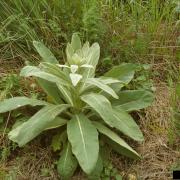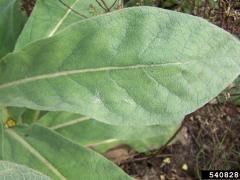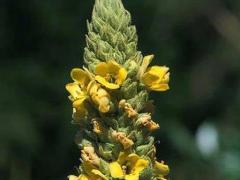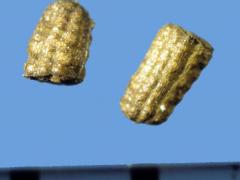Invasive Species: Verbascum thapsus, Common Mullein
Common mullein is a biennial forb native to Eurasia and Africa. Plants are unbranched and can grow to more than 6.6 ft. (2 m) tall. First-year plants develop as a basal rosette of felt-like leaves. Basal leaves are 4-12 in. (10.2-30.5 cm) long, 1-5 in. (2.5-12.7 cm) wide, and covered with woolly hairs. The plant bolts in the second year. Flowering occurs in June to August, when five-petaled, yellow flowers develop at the apex of the shoot. Cauline (stem) leaves are decurrent, alternate, and decrease in size toward the apex. The fruit is an ovoid capsule that splits releasing many seeds that germinate in water. Common mullein was introduced to North America in the mid-1700s as a fish poison.
What are invasive species and why should we be concerned about them?
Taxonomy: Scientific and Common Names for This Species
Scrophulariales > Scrophulariaceae > Verbascum thapsus L.
Synonym(s): big taper, flannel mullein, flannel plant, great mullein, mullein, velvet dock, velvet plant, woolly mullein
Verbascum thapsus – USDA PLANTS Profile
Distribution Maps
Common mullein – The reported distribution of this invasive species across the United States (Source: Invasive Plant Atlas of the United States)
Up-to-the-minute distribution maps and why they are important
Reporting This Invasive Species
What is the best way and place to report the occurrence of an invasive species?
How to report an invasive species sighting to EDDMapS – Early Detection & Distribution Mapping System
EDDMapS – Report an invasive species to EDDMapS.
Cooperative Extension Offices – Find your local Cooperative Extension office on this map provided by USDA.
How to Identify
This invasive species can be identified by looking for the characteristics described in the paragraphs that follow.
Plant
Common mullein is a biennial forb that is unbranched and can grow to more than 6.6 ft. (2 m) tall.
 |
 |
| Joseph M. DiTomaso, University of California-Davis, bugwood.org |
Theodore Webster, USDA Agricultural Research Service, bugwood.org |
Foliage
First-year plants develop as a basal rosette of felt-like leaves. Basal leaves are 4-12 in. (10.2-30.5 cm) long, 1-5 in. (2.5-12.7 cm) wide, and covered with woolly hairs. Cauline (stem) leaves are decurrent, alternate, and decrease in size toward the apex.
 |
 |
| Karan A. Rawlins, University of Georgia, bugwood.org | Bonnie Million, National park Service, bugwood.org |
Flower
Flowering occurs in June to August, when five-petaled, yellow flowers develop at the apex of the shoot.
 |
 |
| Forest & Kim Starr, Starr Environmental, bugwood.org | Joseph M. DiTomaso, University of California-Davis, bugwood.org |
Fruit
The fruit is a ovoid capsule that splits releasing many seeds.
 |
 |
| Mary Ellen (Mel) Harte, bugwood.org | Ken Chamberlain, Ohio State University, bugwood.org |
Native Species That Can Resemble Common Mullein
– Images at invasive.org
| bugwood.org | bugwood.org |
– Images at invasive.org
| bugwood.org | bugwood.org |
Additional Images for Common Mullein
Common mullein – Images at Invasive.org
Additional Information, Biology, Control and Management Resources
Control and management recommendations vary according to individual circumstances. Location, habitat, weather, and a variety of other conditions are factors that help determine the best treatment choice. To find the safest and most effective treatment for your situation, consult your state’s land-grant institution. If you will use chemicals as part of the control process, always refer to the product label.
United States Land-Grant University System – Find your land-grant university’s college of agriculture, Cooperative Extension office, or other related partner on this map provided by USDA.
Weeds Gone Wild: Alien Plant Invaders of Natural Areas – Plant Conservation Alliance
Element Stewardship Abstract – The Nature Conservancy
Weed of the Week – USDA Forest Service
